








|
| |
|
|
| |
THE MOTOR CYCLIST ILLUSTRATED ROAD TEST |
|
| |
| There have been many
excellent British three-wheelers, some have been noted
for performance, others for economy and simplicity of
upkeep, but few for beauty of line. The plastic-bodied
Coronet has a measure of all these qualities, and is
certainly one of the most handsome three-wheelers ever
built.
A product of Coronet Cars Ltd., it
is built in its entirety by James Whitson and Company of
West Drayton, Middle-sex, and distributed in the United
Kingdom by Blue Star Garages Ltd. James Whitson and
Company are an incred-ibly capable group of engineers
who seem to he able to produce anything and well. |
|
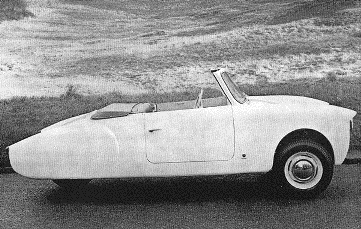 |
|
|
| |
| Since the war they have built
more than a thousand fire engines on a variety of
chassis, and they are highly respected in commercial
vehicle circles for their superb 'bus and coach bodies.
Basis of this handsome three-seater
is a robust chassis frame with 14 gauge channel-section
steel longerons and tubular cross members.Further
tubular outriggers support the bodywork, and a composite
structure of round and rectangular box-section members
form a bridge at the front of the chassis for the
independent suspension. |
|
|
| |
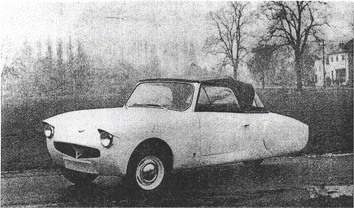 |
|
Front
suspension is by unequal length wishbones and Armstrong
coil spring/damper units. Steering is by forward-mounted
worm and peg steering box and three-piece track-rod. A
12-volt battery for lighting and starting is mounted
within the front suspension framework.
The single rear wheel is
positioned between the extremities of the chassis
longerons and is suspended on a massive swinging-arm.
|
| Movement is controlled by a
single Armstrong coil spring/damper unit, mounted on a
tubular structure to the nearside of the car. All three
pressed-steel wheels have 7 in. Girling hydraulic
brakes.
The 328 c.c. Excelsior
parallel-twin two-stroke engine is mounted behind the
seat, and drives to the rear wheel through a three-speed
and reverse gearbox, final drive being by roller-chain
and sprocket. Cooling is by ducted fan, a stream of air
being drawn in from the nearside and distributed over
the light-alloy cylinder-heads.
First thing to strike the onlooker
upon examining the Coronet is its exceptionally high
finish and excellent detail work. The shapely
glass-fibre bodywork is produced entirely by James
Whitson and Company in relatively large numbers. Since
March 1957 more than 250 Coronets have been built,
current production being about 15 cars per week.
|
| The body-building
process is an interesting one involving in the first
instance the construction of a light-alloy proto-type
shell from which five glass-fibre moulds were made. The
five moulds are bolted together to form the complete
body mould.
First operation is the coating of
the inside of the mould with a release agent. This is to
prevent the treated glass-fibre cloth from adhering to
the mould when dry. Gelcoat, to provide the body's
exceptional outside finish, is applied by brush on to
the release agent. |
|
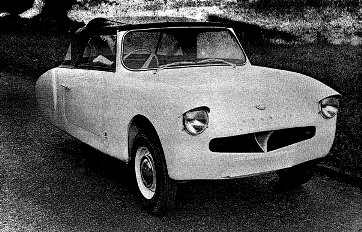 |
| Glass-fibre mat is then built-up
on the Gelcoat layer, and soaked with brush-applied
polyester resins. Several layers are applied and
gradually the body thickness is built up. A hardener is
added, normal time for setting being about six hours at
temperature of 70-80 deg. Fahrenheit. At this stage the
mould sections are unbolted, and the body removed.
Bulkhead mountings are next banded
into position with glass-fibre strips, and all rough
edges are smoothed. Headlamps are fitted and the body is
then fitted to the chassis. Doors, which are produced in
separate moulds are fitted with special piano type
hinges, Whitson-designed and produced. The glass-fibre
dashboard is then bonded into position, and all surface
imperfections are cleaned up prior to painting.
An enamel spray finish is used in
preference to the dyed resins preferred by some plastic
manufacturers. A coat of seal, a coat of primer filler
and two of enamel are applied, and then the windscreen,
sidescreens, hood, instruments, seats, carpets and
trimming are added, resulting in a ,very well-finished
and attractive car. It seems incredible that such a
well-equipped vehicle could weigh less than 8 cwt., but
of course to take advantage of the attractive £5 per
annum three-wheeler tax it must not exceed this figure
with full equipment. Exact all-up dry weight is 7 cwt. 2
qtr. 4 lb. which provides a power-to-weight ratio of
about 45 b.h.p. per ton-comparable to many current
family cars. |
|
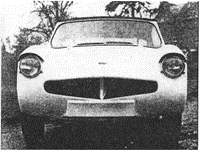 |
Through the courtesy
of Blue Star Garages Ltd., and of James Whitson and
Company, MOTOR CYCLIST ILLUSTRATED was permitted to try
a Coronet. Acceleration was found to be lively, and a 40
m.p.h. cruising speed seemed to suit it very well.
In spite of the gear-change
mechanism not having received its final adjustment, the
shift was found to be easy and the hydraulic brakes very
powerful. |
| The Siba starting equip-ment gave
an instant and silent start from cold, and due to its
petroil lubrication the Coronet can be briskly driven
off at once.
Handling qualities were good, with
oversteering charac-teristics, i.e. if corners were
taken fast, a certain degree of "pay-off" was necessary
half-way through the curve. Driving position was good,
although the writer would have preferred a shorter
steering column. The 47 in. bench type seat is wide
enough to accommodate three adults in reasonable
comfort, or two large males in luxury! |
| A
parcels shelf under the dash, a hood tray and door
pockets all provide useful accommodation, and there is
considerable luggage space in the boot. Fuel tank is
under the "bonnet" where it is raised to the Amal
Monobloc carburetter by S.U. electric pump.
During our brief run the Coronet
excited complimentary comments, and a small throng
invariably gathered wherever it was parked. |
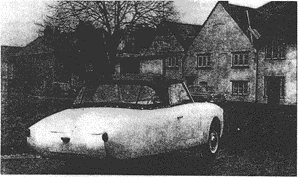 |
|
The exhaust note was suggestive of
power, but was pleasantly subdued, and full acceleration
could be used without creating attention.
The Coronet was tried both in open
form, and with the excellent all-weather equipment
erected. As an open car it was delightful, the curved
windscreen providing good protection. With hood and
sidescreens in place it became a snug coupe with its
good looks, if anything, enhanced. The uncrushable rear
window ensures first-class visibility.
With its turning circle of 31 ft. and
its ground clearance of 7 in., the Coronet is a
thoroughly practical vehicle, besides possessing the
advantages of economical operation and upkeep. It should
come near to ideal general-purpose transport for many
people. |
| |
|
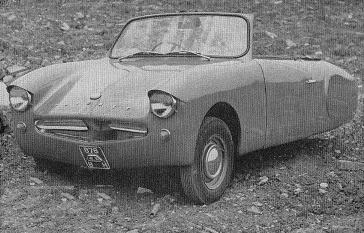 |
|
|
| |
|
|
|
![]()